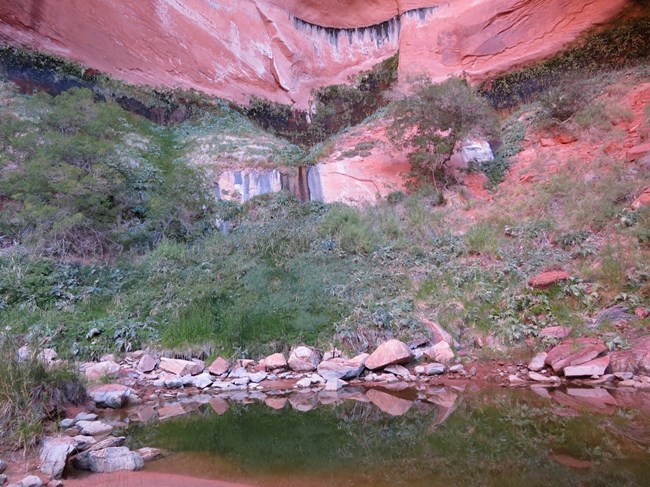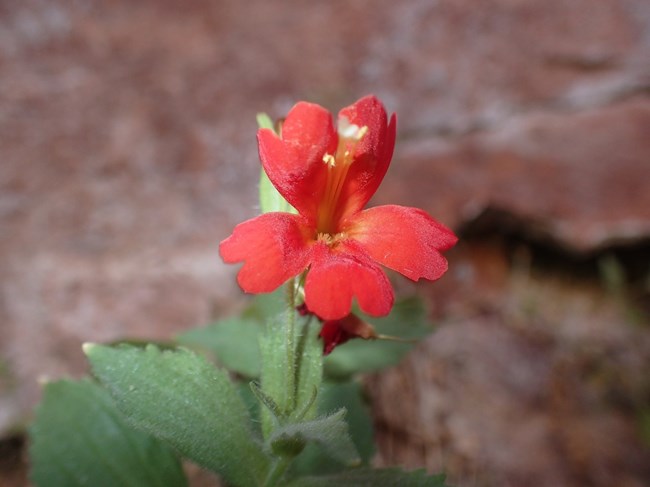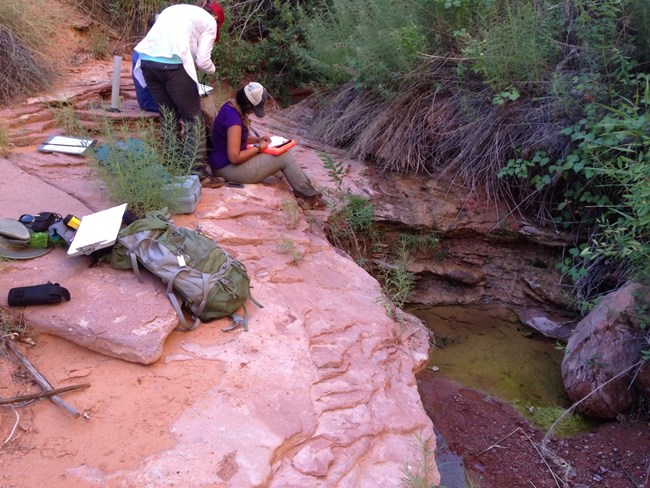Part of a series of articles titled NRCA 2022: Condition of Glen Canyon's Tributary Rivers and Associated Resources.
Article
Small Water, Big Impact: Assessing the Health of Springs, Seeps, and Hanging Gardens
Lake Powell has a lot of water, but you don’t need to wander far from the lakeshore to see that most of Glen Canyon National Recreation Area (NRA) is a rugged desert landscape where water is sparse and difficult to reach. Springs and seeps, along with tinajas and streams, are smaller, but especially important, water sources scattered throughout this arid landscape. The persistence of these water sources is critical to supporting the plants and animals that rely on them.
Springs in Glen Canyon come in many different forms- surfacing in stream channels, emerging from hillslopes, forming wetlands, creating pools, and forming hanging gardens. Hanging gardens are especially common in Glen Canyon and other parts of the Colorado Plateau, but are rare in other parts of the U.S. In these springs, water emerges from a horizontal crack in a cliff wall, forming a cool, sheltered alcove (or hollow) over time.
After his 1869 expedition, John Wesley Powell named Glen Canyon after these distinct, large alcoves or “glens”. Although the waters of Lake Powell covered most of the ones Powell saw along the Colorado River, Glen Canyon NRA still has some of the most impressive hanging gardens on the Colorado Plateau. More than any other type of spring, hanging gardens are hot spots of biodiversity and home to rare plants.
Springs, seeps, and hanging gardens
Springs bring groundwater to the surface while seeps produce water underground that does not always reach the surface. Groundwater from springs and seeps is especially important during drought because the snowmelt and precipitation that feeds streams and tinajas can substantially decrease or even disappear.Springs in Glen Canyon come in many different forms- surfacing in stream channels, emerging from hillslopes, forming wetlands, creating pools, and forming hanging gardens. Hanging gardens are especially common in Glen Canyon and other parts of the Colorado Plateau, but are rare in other parts of the U.S. In these springs, water emerges from a horizontal crack in a cliff wall, forming a cool, sheltered alcove (or hollow) over time.
After his 1869 expedition, John Wesley Powell named Glen Canyon after these distinct, large alcoves or “glens”. Although the waters of Lake Powell covered most of the ones Powell saw along the Colorado River, Glen Canyon NRA still has some of the most impressive hanging gardens on the Colorado Plateau. More than any other type of spring, hanging gardens are hot spots of biodiversity and home to rare plants.
What are the biggest threats to springs and seeps?

NPS Photo
- Decreases in groundwater, from a lower snowpack, changes in precipitation, or pumping of groundwater, reduce the amount of water that springs produce.
- Higher temperatures cause more water to evaporate, leaving less surface water for the plants and animals that rely on springs. During particularly severe droughts, some springs may even dry up.
- Exotic plant species can outcompete native species, which is especially problematic for species that only live at springs.
- Livestock grazing is an important cultural resource permitted on ~60% of park land, but trampling can damage plants and decrease water quality at springs.
- Pollutants from the atmosphere or runoff can contaminate springs and seeps. Water quality is also highly sensitive to disturbances from erosion and recreation.
Assessing conditions at springs and seeps
A recent Natural Resource Condition Assessment (NRCA) through the NPS NRCA Program focused on water-related resources located away from Lake Powell and the mainstem Colorado River. NRCAs evaluate natural resource conditions so that parks can use the best available science to manage their resources. Springs and seeps were one of five focal resources selected for this project, which provided the first parkwide assessment of springs and seeps at Glen Canyon.To do this, ecologists at Utah State University gathered data from published and unpublished reports, online databases, and in the park’s springs database. They summarized this information by spring type, local geology, and watershed. They also evaluated plant health and threats to springs using data collected by the park and compared water quality indicators of selected springs accessible and inaccessible to livestock (12 of each).
What we learned
How many springs are at Glen Canyon? And where can I find them?
- We know there are a LOT of springs and seeps at Glen Canyon. Our study mapped the location of 250 springs in the park that were confirmed by at least one visit, mostly in the Navajo Sandstone and Kayenta geologic formations.
- Hundreds of potential, but unconfirmed, springs were also mapped in the Escalante watershed.

NPS Photo
- Good news! Native plant communities at springs are in relatively good condition.
- Surveys at 185 springs documented 144 native plant species, representing 93% of Glen Canyon’s and 66% of the Colorado Plateau’s recorded wetland species.
- Springs that form pools, wetlands, or hanging gardens had a higher number of plant species than other types of springs.
- Non-native plants were rare at springs, with fewer than three non-native species at most springs.
How intact are springs at Glen Canyon, and what is threatening them?
How’s the water quality at springs? Are livestock degrading water quality at springs?
- An assessment of 29 springs found them to be in fair condition due to threats from climate and natural and human disturbances.
- Most springs (65%) were intact and in good condition, with non-native plants, drought, and flooding as the main threats. Cliff walls protect many springs from human and livestock disturbances by making them difficult to reach.
- 24% of springs had some disturbance and declines, and another 7% were degraded. At these springs, livestock trampling, grazing, and water structures led to additional degradation.
How’s the water quality at springs? Are livestock degrading water quality at springs?
- Mostly, we can’t answer this yet. Baseline water quality data exist for some springs in Glen Canyon, but more data are needed to assess the condition of water quality over time, across watersheds, and by spring type.
- Most water quality indicators (temperature, pH, and dissolved oxygen) were similar in springs accessible vs. inaccessible to livestock. Specific conductance (an indicator of dissolved solids and murkiness) was higher in springs accessible to livestock; however, some springs have naturally higher specific conductance, so it is unclear whether this is a result of livestock disturbance.
What can park managers do with this information?

NPS Photo
- The science in this study can be used to inform park planning and management actions that involve springs or the groundwater that feeds them.
- One result is particularly clear: the park needs additional information on its springs and seeps to better understand how they are vulnerable to various threats and what they can do to protect them.
Park managers initiated long-term monitoring of approximately 20 hanging gardens in 2019, but they still have questions. Future studies should aim to answer these:
- How will the amount and quality of water in springs change with climate change, and how will this affect the plants and animals that depend on them? What can we do to protect these resources in the face of climate change?
- Is livestock or erosion threatening spring and seeps? If so, how can management be adjusted to better protect springs and seeps?
- When does mineral extraction affect springs and seeps?
- Are there airborne contaminants, such as heavy metals or nitrogen fertilization, that could impact water quality of Glen Canyon’s springs that should be monitored?
|
|
|
|
Information in this article was summarized from: Albright J and Others. 2022. Natural resource conditions at Glen Canyon National Recreation Area: Findings & management considerations for selected resources. Natural Resource Report. NPS/SCPN/NRR—2022/2374. National Park Service. Fort Collins, Colorado. https://doi.org/10.36967/nrr-2293112
Read More about the 2022 Glen Canyon NRCA Project >
Visit the NRCA Program Home>
Last updated: July 14, 2022
